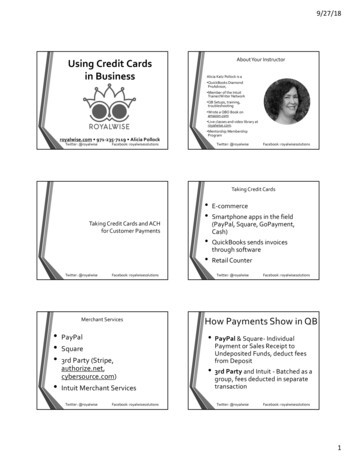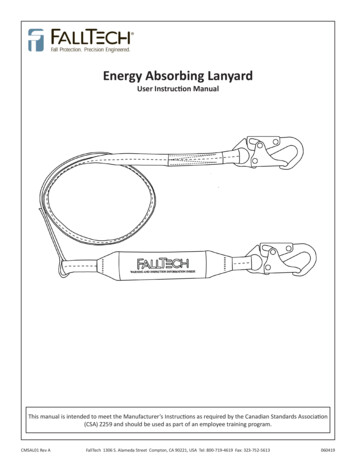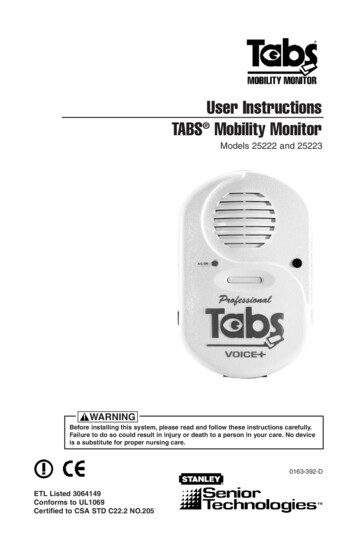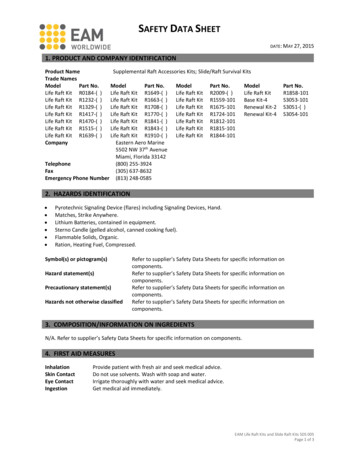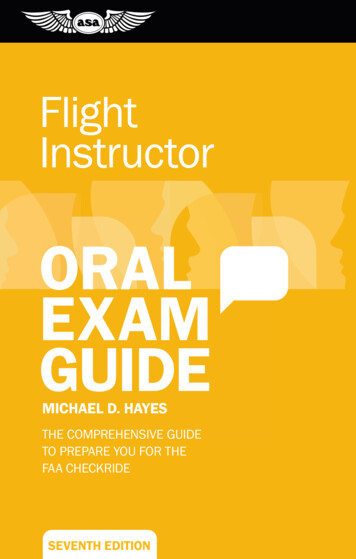
Transcription
Flight Instructor Oral Exam GuideSeventh Editionby Michael D. HayesAviation Supplies & Academics, Inc.7005 132nd Place SENewcastle, Washington 98059-3153Visit ASA’s website often (www.asa2fly.com) to find updates postedthere due to FAA regulation revisions that may affect this book. See alsowww.asa2fly.com/reader/oegcfi for the “Reader Resources” page withadditional information and updates. 1994 –2017 Aviation Supplies & Academics, Inc.All rights reserved. Seventh Edition published 2017.No part of this book shall be reproduced, stored in any retrieval system,or transmitted by any means, electronic, mechanical, xerographic, audio/visual record, or otherwise, without the written permission from thepublisher. While every precaution has been taken in the preparation of thisbook, the publisher and Michael D. Hayes assume no responsibility forerrors or omissions. Neither is any liability assumed for damages resultingfrom the use of the information contained herein. None of the material inthis guide supersedes any documents, procedures, or regulations issued bythe Federal Aviation Administration.Printed in the United States of America202020192018201798765432ASA-OEG-CFI 7ISBN 978-1-61954-503-8Library of Congress Cataloging-in-Publication Data:Hayes, Michael D.Certified flight instructor oral exam guide : the comprehensive guide to prepareyou for the FAA oral exam / by Michael D. Hayes.p.cm.Includes bibliographical references.1. Flight training—Examinations, questions, etc.—Study guides. 2. Airplanes—Piloting—Examinations—Study guides. 3. United States, Federal AviationAdministration—Examinations—Study guides. I. iAviation Supplies & Academics, Inc.1
This guide is dedicated to the many talented students, pilots, and flightinstructors I have had the opportunity to work with over the years.Also special thanks to Mark Hayes, David Sickler, the staff at HowellAircraft Service, and the many others who supplied the patience, encouragement, and understanding necessary to complete the project.— M.D.H.Flight Instructor Oral Exam Guideiii
Contents1 Fundamentals of InstructingA. Human Behavior and Effective Communication.1–3B. The Learning Process.1–8C. The Teaching Process.1–20D. Assessment and Critique.1–26E. Instructor Responsibilities and Professionalism.1–31F. Techniques of Flight Instruction.1–35G. Risk Management.1–40Additional Study Questions.1–452 Flight Instructor ResponsibilitiesA. Aviation Security.2–3B. General.2–4C. Aircraft Rating and Special Certification .2–17D. Student Pilots.2–20E. Recreational Pilots.2–27F. Private Pilots.2–31G. Commercial Pilots.2–35H. Airline Transport Pilots.2–39I. Flight Instructors.2–41Additional Study Questions.2–453 Technical Subject AreasA. Aeromedical Factors.3–3B. Runway Incursion Avoidance.3–5C. Visual Scanning and Collision Avoidance.3–9D. Principles of Flight.3–12E. Airplane Flight Controls.3–17F. Airplane Weight and Balance.3–20G. Navigation and Flight Planning.3–24H. Night Operations.3–27ContinuedFlight Instructor Oral Exam Guidev
I. High Altitude Operations.3–31J. Federal Aviation Regulations and Publications.3–33K. National Airspace System.3–35L. Navigation Systems and Radar Services.3–38M. Logbook Entries and Endorsements.3–44N. Airworthiness Requirements.3–49O. Special Emphasis Areas.3–53Additional Study Questions.3–584 Takeoffs and ClimbsA. Normal Takeoff and Climb.4–3B. Crosswind Takeoff and Climb.4–6C. Short-Field Takeoff and Climb.4–10D. Soft-Field Takeoff and Climb.4–13Additional Study Questions.4–185 Fundamentals of FlightA. Straight-and-Level Flight.5–3B. Level Turns.5–4C. Straight Climbs and Climbing Turns.5–5D. Straight Descents and Descending Turns.5–7E. Practical Test Standards for the Basic Maneuvers.5–9Additional Study Questions.5–106 Slow Flight, Stalls, and SpinsA. Power-On Stalls.6–3B. Power-Off Stalls.6–6C. Crossed-Control Stalls.6–9D. Elevator Trim Stalls.6–11E. Secondary Stalls.6–14F. Spins.6–15G. Maneuvering During Slow Flight.6–18H. Accelerated Maneuver Stalls.6–21Additional Study Questions.6–24viAviation Supplies & Academics, Inc.
7 Basic Instrument ManeuversA. General.7–3B. Straight-and-Level Flight.7–4C. Constant Airspeed Climbs.7–5D. Constant Airspeed Descents.7–6E. Turns to Headings.7–7F. Recovery From Unusual Flight Attitudes.7–8Additional Study Questions.7–118 Performance ManeuversA. Steep Turns.8–3B. Steep Spirals.8–5C. Chandelles.8–6D. Lazy Eights.8–9Additional Study Questions.8–119 Ground Reference ManeuversA. Rectangular Course.9–3B. S-Turns.9–5C. Turns Around a Point.9–7D. Eights-On-Pylons.9–10Additional Study Questions.9–1310 Approaches and LandingsA. Normal or Crosswind Approach and Landing.10–3B. Slips to a Landing.10–7C. Go-Around/Rejected Landing.10–11D. Short-Field Approach and Landing.10–14E. Soft-Field Approach and Landing.10–18F. Power-Off 180 Accuracy Approach and Landing.10–22Additional Study Questions.10–24Flight Instructor Oral Exam Guidevii
11 Emergency OperationsA. Emergency Approach and Landing (Simulated).11–3B. Systems and Equipment Malfunctions.11–4C. Emergency Equipment and Survival Gear.11–6D. Emergency Descent.11–7Additional Study Questions.11–1012 Scenario-Based TrainingIntroduction.12–3Scenario-Based Questions.12–4Appendix 1 Advisory Circular 61-65FAppendix 2 Applicant’s Practical Test ChecklistviiiAviation Supplies & Academics, Inc.
IntroductionThe Flight Instructor Oral Exam Guide is a comprehensive guidedesigned for commercial pilots who are involved in training for theinitial Flight Instructor Certificate.This guide was originally designed for use in a Part 141 school buthas quickly become popular with those training under 14 CFR Part 61who are not affiliated with an approved school. It will also prove beneficial to flight instructors who wish to refresh their knowledge or whoare preparing to renew their flight instructor certificate.The Flight Instructor Practical Test Standards — Airplane book(FAA-S-8081-6) specifies the areas in which knowledge and skill mustbe demonstrated by the applicant before issuance of a flight instructorcertificate with the associated category and class ratings. The FlightInstructor Oral Exam Guide contains questions on the proceduresand maneuvers in the Private Pilot, Commercial Pilot, and InstrumentRating Airman Certification Standards. The performance standardsfor those procedures and maneuvers are also included; these standardsshould be mostly up to the skill level expected of the commercial pilot(FAA-S-ACS-7), unless the maneuver only appears in the PrivatePilot— Airplane Airman Certification Standards (FAA-S-ACS-6). Inthe latter case, the skill level expected of the flight instructor applicantis supposed to be “more precise” than that of a private pilot applicant,determined at the discretion of the examiner (FAA-S-8081-6).During the exam, an FAA examiner will attempt to determinethat the applicant is able to make a practical application of the fundamentals of instructing and is competent to teach the subject matter,procedures, and maneuvers included in the standards to students withvarying backgrounds and levels of experience and ability. Throughvery intensive post-CFI-checkride de-briefings, we have provided youwith the questions most consistently asked along with the informationor the appropriate reference necessary for a knowledgeable response.ContinuedFlight Instructor Oral Exam Guideix
This guide may be supplemented with other comprehensive studymaterials as noted in parentheses after each question; for example:(FAA-H-8083-9). The abbreviations for these materials and theirtitles are listed below. Ensure that the latest revision of these references is used when reviewing for the test. Also, check the ASA websiteat www.asa2fly.com for the latest updates to this book; all the latestchanges in FAA procedures and regulations that affect these questionswill be listed there. In addition to the regular question-and-answer sessions in each chapter, questions for further review have been includedat the end of sections. These additional questions are designed to begood study aids for the references below, upon which they are based.14 CFR Part 1114 CFR Part 4714 CFR Part 6114 CFR Part 6714 CFR Part 68General Rulemaking ProceduresAircraft RegistrationCertification: Pilots and Flight InstructorsMedical Standards and CertificationRequirements For Operating Certain SmallAircraft Without a Medical Certificate14 CFR Part 91General Operating and Flight Rules14 CFR Part 97Standard Instrument Approach Procedures14 CFR Part 119 Certification: Air Carriers and CommercialOperators49 CFR Part 1552 Transportation Security Administration,Civil Aviation Security, Flight SchoolsNTSB Part 830Notification and Reporting of Aircraft Accidentsand IncidentsNPRMNotice of Proposed Rulemaking 2016-6142-001AC 00-2Advisory Circular ChecklistAC 00-6Aviation WeatherAC 00-45Aviation Weather ServicesAC 61-65Certification: Pilots, and Flight and GroundInstructorsAC 61-67Stall and Spin Awareness TrainingAC 61-98Currency Requirements and Guidance for theFlight Review and Instrument Proficiency CheckAC 61-134General Aviation Controlled Flight IntoTerrain AwarenessAC 68-1Alternative Pilot Physical Examination andEducation RequirementsxAviation Supplies & Academics, Inc.
AC 90-23AC 90-48AC 91-63AC 91-67AC 1-6FAA-S-ACS-7FAA-S-ACS-6Order 8900.1AIMPOH/AFMTSAAircraft Wake TurbulencePilots’ Role in Collision AvoidanceTemporary Flight RestrictionsMinimum Equipment Requirements for GeneralAviation Operations under Part 91Parts 91 and 135 Single Pilot, Flight SchoolProcedures During Taxi OperationsAircraft Weight and Balance HandbookRisk Management HandbookAirplane Flying HandbookAdvanced Avionics HandbookAviation Instructor’s HandbookInstrument Flying HandbookPilot’s Handbook of Aeronautical KnowledgeStudent Pilot GuideAviation Maintenance Technician Handbook:Airframe Volume 1On Landings – Part IIIInstrument Rating – Airplane Airman CertificationStandardsFlight Instructor Practical Test Standards(Airplane Single- and Multi-Engine)Commercial Pilot – Airplane Airman CertificationStandardsPrivate Pilot – Airplane Airman CertificationStandardsFlight Standards Information Management SystemAeronautical Information ManualPilot Operating Handbooks and FAA-ApprovedFlight ManualsTransportation Security AdministrationChart Supplement U.S. (formerly A/FD)Most of the publications listed above are reprinted by ASA and areavailable from aviation retailers worldwide.A review of the information and references presented within thisguide should provide the necessary preparation for the FAA initialFlight Instructor certification check.Flight Instructor Oral Exam Guidexi
Were you asked a question during your checkride that was notcovered in this book? If so, please send the question to ASA. We areconstantly striving to improve our publications to meet the industryneeds.Aviation Supplies & Academics, Inc.7005 132nd Place SENewcastle, WA 98059-3153email: asa@asa2fly. comFax:425.235.0128xiiAviation Supplies & Academics, Inc.
Chapter 1 Fundamentals of InstructingA. Human Behavior and EffectiveCommunication1. What is the definition of human behavior? (FAA-H-8083-9)Human behavior is the product of factors that cause people to act inpredictable ways. It can also be defined as the result of a person’sattempt to satisfy certain needs. A working knowledge of humanbehavior can help an instructor better understand students.2. Control of human behavior involves understandinghuman needs. What are these basic needs, and how arethey important to the instructor-student relationship? (FAA-H-8083-9)a. Physiological — The need for air, food, water; unless thesebiological needs are met, a person cannot concentrate fully onlearning.b. Security — If a student does not feel safe, they cannot concentrate on learning.c. Belonging — Students are usually out of their normal surroundings during training, and their need for association andbelonging is more pronounced.d. Self-esteem — Humans have a need for a stable, firmly based,high level of self-respect and respect from others. High selfesteem results in self-confidence, independence, achievement,competence, and knowledge.e. Cognitive — Humans have a deep need to understand what isgoing on around them. When a person understands what isgoing on, he or she can either control the situation or make aninformed choice about what steps might be taken next.f. Aesthetic — Needs connect directly with human emotions.When someone likes another person or an object, the reasonsare not examined — he or she simply likes it. This need canfactor into the student-instructor relationship.g. Self-actualization — A person’s need to be and do that whichthe person was “born to do.” Helping a student achieve his orher individual potential in aviation offers the greatest challengeas well as reward to the instructor.Flight Instructor Oral Exam Guide1– 3
Chapter 1 Fundamentals of Instructing3. What are defense mechanisms? (FAA-H-8083-9)Defense mechanisms are subconscious ego-protecting reactions tounpleasant situations. They soften feelings of failure, alleviate feelings of guilt, help an individual cope with reality, and protect one’sself-image.4. Explain the eight common defense mechanisms thatmay apply to students. ( FAA-H-8083-9)Repression — A person places uncomfortable thoughts into inaccessible areas of the unconscious mind. Thoughts or information aperson is unable to cope with are pushed away, to be dealt with atanother time, or never.Denial — A refusal to accept external reality because it is toothreatening. Denial is the refusal to acknowledge what hashappened, is happening, or will happen.Compensation — Students often attempt to disguise the presence ofa weak or undesirable quality by emphasizing a more positive one.Projection — Students may relegate the blame for their own shortcomings and mistakes to others or attribute their motives, desires,and characteristics to others.Rationalization — Justifying actions that otherwise would be unacceptable; the substitution of excuses for reasons.Reaction formation — Faking a belief opposite to the true beliefbecause the true belief causes anxiety.Fantasy — A student engages in daydreaming about how thingsshould be rather than doing anything about how things are.Displacement — An unconscious shift of emotion, affect, or desirefrom the original object to a more acceptable, less-threateningsubstitute. It avoids the risk associated with feeling unpleasantemotions by transferring them toward someone or somethingunthreatening.5. What is the definition of anxiety and why is a student’sanxiety of concern to an instructor? ( FAA-H-8083-9)Anxiety is a feeling of worry, nervousness, or unease, often aboutsomething that is going to happen — typically something withan uncertain outcome. It results from the fear of anything, real1– 4Aviation Supplies & Academics, Inc.
Chapter 1 Fundamentals of Instructingor imagined, that threatens the person who experiences it, andmay have a potent effect on actions and the ability to learn fromperceptions.6. How can an instructor help students counter theiranxieties? ( FAA-H-8083-9)Anxiety can be countered by reinforcing the student’s enjoyment offlying and by teaching them to cope with their fears. An effectivetechnique is to treat fears as a normal reaction, rather than ignoringthem. Instructors should introduce certain types of operations andmaneuvers (e.g., stalls) with care, so that students know what toexpect and how to react.7. What are several examples both of a student’s normalreactions and abnormal reactions to stress?Normal reactions — Responds rapidly and exactly within the limitsof their experience and training; the individual thinks rationally,acts rapidly, and is extremely sensitive to all aspects of theirsurroundings.Abnormal reactions — The response to anxiety or stress may becompletely absent or at least inadequate; response may be randomor illogical or may be more than is called for by the situation.8. What are the three basic elements of communication? (FAA-H-8083-9)Source — speaker, writer, or instructorSymbols — words or signsReceiver — listener, reader, or student9. Explain the three characteristics that instructorsmust understand about their students before effectivecommunication can take place. (FAA-H-8083-9)a. Abilities — An instructor needs to determine the abilities of thestudent in order to properly communicate.b. Attitudes — The attitudes that students exhibit may indicateresistance, willingness, or passive neutrality.c. Experiences — Student experience, background, and educational level determine the approach an instructor takes.Flight Instructor Oral Exam Guide1– 5
FAA-H-8083-27 Student Pilot Guide FAA-H-8083-31 Aviation Maintenance Technician Handbook: Airframe Volume 1 FAA-P-8740-50 On Landings - Part III FAA-S-ACS-8 Instrument Rating - Airplane Airman Certification Standards FAA-S-8081-6 Flight Instructor Practical Test Standards

